Conversion in progress ...
Please wait while we generate your PDF
The Ultimate Guide to Home Staging for Sellers
Title
Lorem ipsum dolor sit amet, consectetur adipiscing elit. Suspendisse varius enim in eros elementum tristique.
Lorem ipsum dolor sit amet, consectetur adipiscing elit. Suspendisse varius enim in eros elementum tristique.
Table of Contents
Introduction
• The Importance of home staging in real estate
• How effective staging can significantly impact home sales prices
Understanding Home Staging
• Definition of home staging
• Why it is crucial for home sales
• The psychology behind effective home staging
Planning Your Home Staging
• The initial walkthrough: assessing your property
• Prioritizing areas for staging
• Planning your staging: theme, decor, budget
Key Principles of Home Staging
• De-cluttering
• Maximizing space
• Neutralizing and modernizing
• Importance of lighting
• Inviting curb appeal
Room-by-Room Guide to Staging
• Staging the kitchen
• Staging the living room
• Staging the bedroom(s)
• Staging the bathroom(s)
• Staging outdoor spaces
Home Staging Mistakes to Avoid
• Overpersonalization
• Neglecting minor repairs
• Overlooking the importance of cleanliness
How to create Engaging Home Staging Videos
• Choosing the right equipment
• Setting the scene for filming
• Filming tips: angles, lighting, duration
• Sharing your video: platforms and strategies
Conclusion
• Recap of key points
• Encouragement to apply knowledge and experiment
• How to stay updated in home staging trends
Appendix
• Home Staging Checklist
• Equipment Checklist for Home Staging Videos
• Sample Scripts for Home Staging Videos
Introduction

In the competitive world of real estate, presenting a house in its best light is crucial. Home staging—the art of preparing and presenting a property — can significantly impact your house listing's time on market, final sale price, and overall buyer appeal. This eBook is a how-to guide that will help you stage your home to impress buyers and stand out in the real estate market.

Understanding Home Staging
Definition of Home Staging
Home staging is the process of making a property appealing to the highest number of potential buyers, in order to to sell the property more swiftly and for more money. It is about strategically arranging furniture and décor to highlight a home's best features and potential, making it easy for buyers to envision themselves living in the space. It involves a range of activities, from minor clean-ups and decluttering to comprehensive design and redecoration.
The Importance of Home Staging
Staging a home plays a significant role in the selling process for several reasons:
- Faster Sale: Staged homes often sell faster than non-staged homes. When buyers can imagine themselves living in a house, they're more likely to make an offer.
- Higher Selling Price: Staged homes usually sell for a higher price than non-staged ones. When a house looks move-in ready, buyers are willing to pay a premium.
- Better Photos for Listings: In the digital age, the first impression of a house usually comes from online listings. Staged homes often look better in photographs and attract more potential buyers.
- Stand Out in the Market: A staged home stands out from the competition, making it an easy choice for buyers.
Psychology Behind Effective Home Staging
The psychology behind home staging comes down to one key idea: potential buyers need to be able to envision themselves in the home. The staging process involves depersonalizing the space and setting it up in a way that appeals to a broad range of tastes. It's about striking a balance between a lived-in, cozy feel and a clean, inviting look that allows potential buyers to imagine their own lives in the space.
Planning Your Home Staging
Just like any project, successful home staging starts with effective planning. A well-thought-out plan will not only ensure that your home staging efforts are consistent and cohesive, but it can also help you save time and money by avoiding costly mistakes and unnecessary purchases. Here are some key considerations when planning your home staging:
The Initial Walkthrough: Assessing Your Property
The first step in your planning process should be a comprehensive walkthrough of the property. This walkthrough isn't just about noting what furniture is present or what color the walls are painted; it's about viewing your home through the eyes of a potential buyer. Here's what to look for during your initial walkthrough:
- First Impressions: What's the first thing you notice when you walk in the door? This is likely what potential buyers will notice as well.
- Highlights and Concealments: What are the home's best features, and how can you highlight them? Conversely, what are its weakest areas, and how can you downplay or improve them?
- Clutter and Cleanliness: Are there areas that are excessively cluttered or particularly dirty? These are instant turn-offs for buyers and need to be addressed.
- Repairs and Upgrades: Are there any minor repairs that need to be taken care of? Would any rooms benefit from a fresh coat of paint or a hardware upgrade?